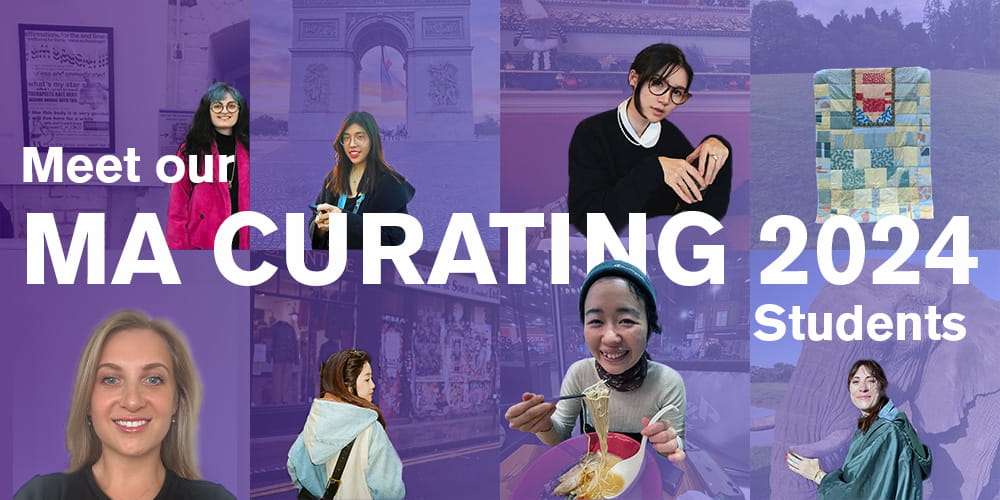Every year MA Curating students who take the AR953 module work together to present an exhibition in Art Exchange. In this blog post, authored by MA Curating student Emma Stanley, we meet the class of 2024 and introduce you to their degree show, Lavender Menace.

Meet the students
We are a team of eight MA Curating students who all from very different backgrounds and experiences:
Ruby Bowd
A queer and non-binary textile designer and artist who uses knit and fabrics to explore ideas of comfort. Ruby is hoping to pursue a career in Art History through museums and galleries.
Ieva Cebatoriute
A graduate of the University of Essex’s BA in Art History, which built their theoretical knowledge of the impact of the arts on social change. Ieva is studying for an MA in Curating to put the theory into practice and possibly turn it into a career in the art industry.
Yuwn Cao
A feminist and calligrapher. She has worked as a curator and comic editor specialising in LGBTQ+ comics.
Yutang Chang
A graduate of the National Taiwan University of Arts, she studied and specialised in traditional ink painting and calligraphy. She has also worked for the Art Gallery and the Taipei Art Gallery Association as an administrative project for the largest art fair in Taiwan, and has a passion for managing exhibitions.
Jou-Han Chen
Formerly the executive manager of the Illustration Fair in Taipei, Taiwan. She expresses a keen interest in the realms of art, music, travel, and the appreciation of coffee. She has cultivated interests in proposal writing, public relations, social media management, marketing, and commercial market research in the art and curatorial industry.
Tilly Hawkins
A graduate of Essex’s BA in Curating and has previously studied Fine Art at the Colchester Institute. Tilly is interested in public art, protest posters, and artistic interventions into museum collections.
Hiromi Horiuchi
A former contemporary art gallery Director in Tokyo. Hiromi values the support and communication which is followed by each artist's individuality to make them focus on their creativity, and also, likes to visit a wide range of exhibitions.
Emma Stanley
A History graduate from the University of Kent, and a former Secondary School History teacher, obsessed with cats, plants and anything related to the past, hoping to transition into the exciting world of museums.
Choosing the theme
While our diversity is our strength, it did make choosing a theme for our exhibition difficult. We eventually agreed on the theme of the language of queer feminism, in a roundabout way...
Initially, we were looking at how each of us has experienced the need to ‘mask’ and hide parts of our identity in the past, present, and future. We discussed the need to ‘mask’ mental health issues, gender stereotypes, learning difficulties and ethnic differences, for example. A prominent theme within this discussion was sexuality. We decided to focus on queer sexuality due to its, in our opinion, often-overlooked intersection with feminism, an ideology we all felt passionate about. Therefore, the exhibition is inspired by the historic exclusion of queer women by UK legislature, which historically focused on queer men.
A Lavender Menace
On reflection, we decided that the message we really wanted to convey was not the masking that we have had to endure, but how we can be empowered through the act of ‘unmasking’- being direct and often confrontational about our characteristics. This act of empowerment is often transmitted through language. As a result, our exhibition centres around seven artists that have reclaimed language as a means of expressing their identity and sexuality, with feminist motivations at their core.
We are honoured to be featuring artworks in a variety of mediums, including textiles, zines and mosaics, by Mirta Cerioli, Sarah-Joy Ford, Caroline Glover, Helen Maguire, Liberty Antonia Sadler, Anna Sampson, and E L West.
We found that the artworks often engage directly with historical protest material: they create a continuity between past and present uses of language for activism. Therefore, we are including archival material, from the Bishopsgate Institute and the University of Essex Special Collections, to provide historical context, offering a comparative analysis of manifestations of queer sexuality. Within this, historically demonising phrases, such as ‘lavender menace’, are reclaimed and refashioned, displaying the continual language evolution. Therefore, both mediums, art and archival material, are connected by the written word's power to convey desire, assert identity, and challenge societal constructions of gender and sexuality.
Recognising the ongoing discrimination faced by the queer community, Lavender Menace aims to explore queerness in an inclusive and educational context.
The exhibition
Lavender Menace opens on Friday 26 April, with a Launch Party on 25 April, both in Art Exchange. The exhibition will run until Friday 31 May and will be complemented by a public programme of artist talks and workshops.






